Shopping Cart
Remove All Your shopping cart is currently empty
Your shopping cart is currently empty
Galangin (Norizalpinin) is an agonist/antagonist of the arylhydrocarbon receptor, and also shows inhibition of CYP1A1 activity.

| Pack Size | Price | USA Warehouse | Global Warehouse | Quantity |
|---|---|---|---|---|
| 5 mg | $30 | In Stock | In Stock | |
| 10 mg | $47 | In Stock | In Stock | |
| 25 mg | $77 | In Stock | In Stock | |
| 50 mg | $123 | In Stock | In Stock | |
| 100 mg | $217 | In Stock | In Stock | |
| 500 mg | $543 | In Stock | In Stock | |
| 1 mL x 10 mM (in DMSO) | $52 | In Stock | In Stock |
| Description | Galangin (Norizalpinin) is an agonist/antagonist of the arylhydrocarbon receptor, and also shows inhibition of CYP1A1 activity. |
| In vitro | Through thin-layer chromatography, it has been demonstrated that Galangin impedes the catabolic decomposition of DMBA in a dose-dependent fashion and obstructs the generation of DMBA-DNA adducts, thereby averting DMBA-related suppression of cell proliferation. Additionally, Galangin robustly curtails CYP1A1 enzyme activity in a dose-responsive manner within both intact cells and DMBA-exposed cell-derived microsomes, as ascertained through ethoxyresorufin-O-deethylase activity assays. The inhibition of CYP1A1 by Galangin occurs through a noncompetitive mechanism, as evidenced by double-reciprocal plot analysis. Moreover, Galangin elevates CYP1A1 mRNA levels, suggesting potential aryl hydrocarbon receptor agonism, yet it counteracts the DMBA or TCDD-triggered upregulation of CYP1A1 mRNA and promoter-driven transcription[1]. Furthermore, Galangin administration hampers cell proliferation while propelling autophagy at 130 μM and apoptosis at 370 μM. Specifically, in HepG2 cells, Galangin induces autophagosome accumulation, enhances microtubule-associated protein light chain 3 levels, and augments the proportion of vacuolated cells, alongside a surge in p53 expression. The Galangin-induced autophagic response is mitigated by p53 inhibition in HepG2 cells, while p53 overexpression in Hep3B cells normalizes the elevated vacuole presence[2]. |
| Cell Research | Cells (5.0×103) are seeded and treated with different concentrations of galangin for different periods of time in 96-well plates. The number of viable cells in each well is determined by adding 10 μL of 5 mg/mL MTT solution. Following the 4 hour incubation at 37°C, the cells are dissolved in a 100 μL solution containing 20% SDS and 50% dimethy formamide. The optical densities are quantified at a test wavelength of 570 nm with a reference wavelength of 630 nm using a Varioskan Flash Reader spectrophotometer. |
| Synonyms | Norizalpinin, 3,5,7-Trihydroxyflavone |
| Molecular Weight | 270.24 |
| Formula | C15H10O5 |
| Cas No. | 548-83-4 |
| Smiles | Oc1cc(O)c2c(c1)oc(-c1ccccc1)c(O)c2=O |
| Relative Density. | 1.579 g/cm3 |
| Color | Yellow |
| Appearance | Solid |
| Storage | Powder: -20°C for 3 years | In solvent: -80°C for 1 year | Shipping with blue ice/Shipping at ambient temperature. | |||||||||||||||||||||||||||||||||||
| Solubility Information | Chloroform, Dichloromethane, Ethyl Acetate, Acetone: Soluble DMSO: 237 mg/mL (877 mM), Sonication is recommended. | |||||||||||||||||||||||||||||||||||
| In Vivo Formulation | 10% DMSO+40% PEG300+5% Tween 80+45% Saline: 5 mg/mL (18.5 mM), Sonication is recommended. Please add the solvents sequentially, clarifying the solution as much as possible before adding the next one. Dissolve by heating and/or sonication if necessary. Working solution is recommended to be prepared and used immediately. The formulation provided above is for reference purposes only. In vivo formulations may vary and should be modified based on specific experimental conditions. | |||||||||||||||||||||||||||||||||||
Solution Preparation Table | ||||||||||||||||||||||||||||||||||||
DMSO
| ||||||||||||||||||||||||||||||||||||
| Size | Quantity | Unit Price | Amount | Operation |
|---|

Copyright © 2015-2025 TargetMol Chemicals Inc. All Rights Reserved.